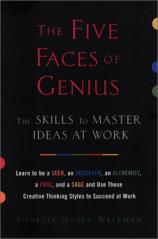The Five Faces of Genius: The Skills to Master Ideas at Work
Review
The Five Faces of Genius: The Skills to Master Ideas at Work
The person who figures a way to bottle creativity may easily end up with a bank account that could rival Bill Gates's. While no one has found the recipe yet, Annette Moser-Wellman has come close to a concoction that at least works well for a book. Specifically her book, THE FIVE FACES OF GENIUS: The Skills to Master Ideas at Work.
Moser-Wellman, who became interested in creativity as a former ad exec, is now president of her own consulting firm. She says that the most valuable resource you can bring to your work is creativity; ideas are what matter. Creativity is the true engine behind such business successes as McDonald's, Amazon.com, and Starbucks. She also says it's business's "most valuable asset in times of great change."
She became so interested in creativity and its potential for business that she started researching common traits of creative people. And Moser-Wellman concluded that the creative mind is the same no matter where it's found; Robert Frost used basically the same skills to write a poem as Howard Schultz used to create Starbucks. She also discovered that there are five types of creative people --- Seers, Observers, Alchemists, Fools, and Sages.
Seers can visualize pictures and use them to create ideas. Observers notice details and collect them to build an idea. The alchemist brings different ideas, disciplines, or systems of thought and connects them in a unique way. The fool can celebrate weakness by practicing three related skills: excelling at inversion, finding sense in absurdity, and using perseverance. The sage uses the powers of simplification to strip problems to their core.
Then to help readers find which of these faces they are, Moser-Wellman has included a 40-question survey. She says people are often dominant in one of the faces, but the book's real goal is to help readers master all of the faces and use them regularly. And so, after a thorough explanation of each face, she offers practical suggestions and exercises at the end of the chapters on how people can see through the eyes of these five faces and use this to their advantage.
For example, if a sage needs to create a name for a candy shop, he would likely come up with something simple and easy to remember, "Dandy Candy." But, if the sage takes time to look at the problem through the other faces' eyes, the sage may come up with something he likes that has even more impact. If the sage looks at possible names through a seer's eyes, he might come up with something that helps a customer remember the store better, such as "The Candy Cane." And so on down the list of faces.
So each face is kind of a "creativity well" people can dip into for more interesting and better ideas. And while each well is deep, with lots of good potential, the well's contents don't come in bottle-form. But the book is tasty. Buy it, open it and drink deep. Bottoms up!
Reviewed by Doug McPherson on March 19, 2001
The Five Faces of Genius: The Skills to Master Ideas at Work
- Publication Date: March 19, 2001
- Genres: Business, Nonfiction
- Hardcover: 208 pages
- Publisher: Viking Adult
- ISBN-10: 067089477X
- ISBN-13: 9780670894772



